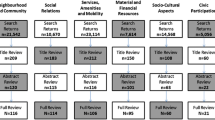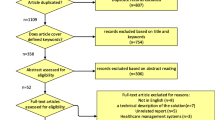Abstract
The process of aging is gradually changing in urban India. In most of the gerontological literature of India, older adults have been projected as frail, disengaged and detached. However, the experience of growing old is transforming in urban areas of India. Recently a new class of older Indians are emerging who are financially independent, retain their freedom of choice, rely on means outside the family system to remain engaged and aim to have a meaningful old age. Within India, a large number of older adults who belong to the upper class, reside in Kolkata due to migration patterns, employment opportunities and urbanization. Hence Kolkata, is home to two sets of upper class older adults: those who live alone and those who live with their adult children and their families. Adopting a socio gerontological lens and relying on in-depth qualitative interviews, the current study examines the lived experiences of growing old among upper class older adults of urban Kolkata. The study also draws from the social aging frameworks of activity and role theory and compares the processes of aging among the above mentioned two groups of older adults. Findings from the study suggest, that after the loss of a particular role due to life changing events such as widowhood, retirement or becoming a grandparent, older adults in both the groups develop new roles to have a purpose in their later lives. Finally, the study also highlights how gender and living arrangement determine the lived experience of aging.
Similar content being viewed by others
References
Allendorf, K. (2012). Women’s agency and the quality of family relationships in India. Population Research and Policy Review, 31(2), 187–206.
Ara, S. (1997). Housing facilities for the elderly in India. Ageing International, 23(3–4), 107–114.
Babbie, E. (2012). Research methods in sociology. New Delhi: Cengage Delmar Learning India Pvt.
Bandyopadhyay, K. (2008). The nation and its fragments: Football and Community in India. Soccer & Society, 9(3), 377–393.
Barik, D., Agrawal, T., & Desai, S. (2015). After the dividend: Caring for a greying India. Economic and Political Weekly, 50(24), 108–112.
Bhat, A. K., & Dhruvarajan, R. (2001). Ageing in India: Drifting intergenerational relations, challenges and options. Ageing & Society, 21(5), 621–640.
Bhattacharya, T., Chatterjee, S. C., Chand, D., Chaterjee, D., & Sengupta, J. (2017). Assessment of private homes as spaces for the dying elderly. Indian Journal of Palliative Care, 23(3), 325–330.
Biswas, D., Gupta, A. D., Amitava, K., et al. (2015). A study on hypertension in geriatric population in a slum of Kolkata. International Journal of Medical Science and Public Health, 4(11), 1527–1531.
Chakraborty, S., Chatterjee, S., Das, K., & Roy, U. (2015). Changing pattern of urbanization in West Bengal: An analysis of 2011 census of India data. Asian Journal of Research in Social Sciences and Humanities, 5(5), 169–181.
Cohen, L. (1998). No aging in India: Alzheimer's, the bad family, and other modern things. Berkley: University of California Press.
Creswell, J. W. (2013). Research design qualitative, quantitative and mixed methods approach. USA: Sage.
Das, S. K., Biswas, A., Roy, J., et al. (2008). Prevalence of major neurological disorders among geriatric population in the metropolitan city of Kolkata. The Journal of the Association of Physicians in India, 56, 175–181.
Dey, A. (2017). Depression among elderly residents of Kolkata: A comparative study on pre retirement and post retirement conditions of elderly. International Journal of Home Science, 3(3), 159–162.
Diggs, J. (2008). Activity theory of aging. In S. Loue & M. Sajatovie (Eds.), Encyclopedia of aging and public health (pp. 79–81). New York: Springer.
Ekerdt, D. J. (1986). The busy ethic: Moral continuity between work and retirement. The Gerontologist, 26(3), 239–244.
Gangopadhyay, J. (2017). Aging across worlds: Examining intergenerational relationships among older adults in two cities in transition. Ageing International, 42(4), 504–521.
Gangopadhyay, J., & Samanta, T. (2017). ‘Family matters’: Ageing and the intergenerational social contract in urban Ahmedabad, Gujarat. Contributions to Indian Sociology, 51(3), 338–360.
Ghosh, P., & Dey, A. (2009). Views on ageing and dying of elderly persons of differing socioeconomic status. Ageing and Society: The Indian Journal of Gerontology, 19(3 and 4), 27–43.
Gulati, L., & Rajan, S. I. (1999). The added years: Elderly in India and Kerala. Economic and Political Weekly, 34(44), 46–51.
Gupta, K. (2014). Baboos, Bibis and the Bangals of Kolkata. The Pioneer. Accessed at http://www.dailypioneer.com/columnists/coffee-break/baboos-bibis-and-the-bangals-of-kolkata.html. Accessed 5 Aug 2018.
Havighurst, R. J. (1961). Successful aging. The Gerontologist, 1(1), 8–13.
Hooyman, N. R., & Kiyak, H. A. (1996). Social theories of aging. In N. R. Hooyman, & H. A. Kiyak (Eds.), Social gerontology: A multidisciplinary perspective (4 ed., pp. 66–89). Needham Heights: Allyn and Bacon.
Khan, G. S. (2013). Partition-migration in Bengal: Political schism and regional-cultural divide. Sociology and Anthropology, 1(2), 72–75.
Knapp, M. (1977). The activity theory of aging: An examination in the English context. The Gerontologist, 17(6), 553–559.
Krause, N., Herzog, A. R., & Baker, E. (1992). Providing support to others and well-being in later life. Journals of Gerontology, 47(5), P300–P311.
Lamb, S. (Ed.). (2009). Aging and the Indian diaspora: Cosmopolitan families in India and abroad. Indiana University Press.
Lamb, S. (2013). In/dependence, intergenerational uncertainty, and the ambivalent state: Perceptions of old age security in India. Journal of South Asia, 36(1), 65–78.
Lamb, S. (2014). Permanent personhood or meaningful decline? Toward a critical anthropology of successful aging. Journal of Aging Studies, 29, 41–52.
Lemon, B. W., Bengston, V. L., & Peterson, J. A. (1972). An exploration of the activity theory of aging: Activity types and life satisfaction among in-movers to a retirement community. Journal of Gerontology, 27(4), 511–523.
Liebig, P. S., & Irudaya Rajan, S. (Eds.). (2003). An aging India: Perspectives, prospects and policies. USA: Haworth Press.
Madan, N. T. (1993). The Hindu family and development. In P. Uberoi (Ed.), Family, kinship and marriage in India (pp. 416–434). New Delhi: Oxford University Press.
Mead, G. H. (1934). Mind, self, and society: From the standpoint of a social behaviorist. Chicago: University of Chicago Press.
Ministry of Statistics and Programme Implementation. (2016). Elderly in India. Accessed at http://mospi.nic.in/sites/default/files/publication_reports/ElderlyinIndia_2016.pdf. Accessed 3 Aug 2018.
Mishra, U. S., & Rajan, I. (2017). India’s aged: Needs and vulnerabilities. New Delhi: Orient Blackswan.
Nandy, C. (2017). Ghotis and Bangals: Decoding a very Bengali rivalry. The Quint. Accessed at https://www.thequint.com/campaigns/bol/ghotis-and-bangals-decoding-a-very-bengali-rivalry. Accessed 7 Aug 2018.
Noy, C. (2008). Sampling knowledge: The hermeneutics of snowball sampling in qualitative research. International Journal of Social Research Methodology, 11(4), 327–344.
Pal, C. (2016). Old is gold: How Kolkata’s greying population is feeding a new kind of business. Scroll. Accessed at https://scroll.in/article/802543/old-is-gold-how-kolkatas-greying-populationis-feeding-a-new-kind-of-business. Accessed 5 Aug 2018.
Paltasingh, T., & Tyagi, R. (2015). Tyagi (Ed.), Caring for the elderly: Social gerontology in the Indian Context. New Delhi: Sage Publications India.
Pew Research Centre. (2011). A global middle class is more promise than reality. Accessed at http://assets.pewresearch.org/wp-content/uploads/sites/2/2015/08/Global-Middle-Class-Report_8-12-15-final.pdf. Accessed 4 Aug 2018.
Rajan, S. I., & Kumar, S. (2003). Living arrangements among Indian elderly: New evidence from national family health survey. Economic and Political Weekly, 38(1), 75–80.
Rao, A. V. (1991). Suicide in the elderly: A report from India. Crisis: The Journal of Crisis Intervention and Suicide Prevention, 12(2), 33–39.
Rook, K. S., & Sorkin, D. H. (2003). Fostering social ties through a volunteer role: Implications for older-adults’ psychological health. The International Journal of Aging and Human Development, 57, 313–337.
Samanta, T., Chen, F., & Vanneman, R. (2015). Living arrangements and health of older adults in India. The Journals of Gerontology Series B: Psychological Sciences and Social Sciences gbul, 64, 1–10.
Shah, A. M. (1999). Changes in the family and the elderly. Economic and Political Weekly, 34(20), 1179–1182.
Shamshad, R. (2017). Bengaliness, Hindu nationalism and Bangladeshi migrants in West Bengal, India. Asian Ethnicity, 18(4), 433–451.
Shankardass, M. K. (2018). Perspectives on abuse and neglect of the elderly in India. In M. K. Shankardass & I. Rajan (Eds.), Abuse and neglect of the elderly in India (pp. 19–27). Singapore: Springer.
Van Willigen, J., & Chadha, N. K. (1999). Social aging in a Delhi neighborhood. Greenwood Publishing Group.
Vatuk, S. (1975). Gifts and affines in North India. Contributions to Indian Sociology, 9(2), 155–196.
Vera-Sanso, P. (2005). They don’t need it, and I can’t give it’: Filial support in South India In P. Kreager (Ed.), Aging without children: european and asian perspectives on elderly access to support networks. (pp. 77–105). New York: Oxford: Berghahn Books.
Verma, V., & Akhtar, S. (2008). Where have all the young ones gone? The Telegraph. Accessed at https://www.telegraphindia.com/1080203/jsp/7days/story_8857329.jsp. Accessed 7 Aug 2018.
Verma, S. K., & Satayanarayana, A. (2013). Process of intergenerational ambivalence: A qualitative inquiry. Marriage & Family Review, 49(8), 737–753.
Willigen, M. V. (2000). Differential benefits of volunteering across the life course. The Journals of Gerontology: Series B, 55(5), S308–S318.
Author information
Authors and Affiliations
Corresponding author
Ethics declarations
Conflict of Interest
The author declares that there is no conflict of interest as this is a sole authored paper.
Informed Consent
Informed consent was obtained from each participant before the interviews were conducted.
Ethical Treatment of Experimental Subjects
Though human participants were interviewed, prior informed consent was obtained from each of the participant and only then were the interviews conducted.
Additional information
Publisher’s Note
Springer Nature remains neutral with regard to jurisdictional claims in published maps and institutional affiliations.
Rights and permissions
About this article
Cite this article
Gangopadhyay, J. Examining the Changing Processes of Aging in Urban Kolkata. Ageing Int 45, 273–287 (2020). https://doi.org/10.1007/s12126-019-09352-y
Published:
Issue Date:
DOI: https://doi.org/10.1007/s12126-019-09352-y




